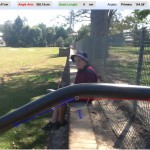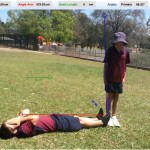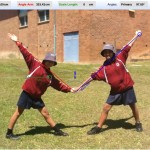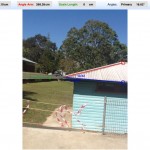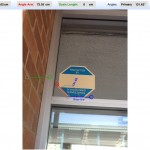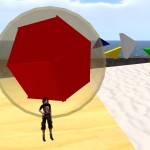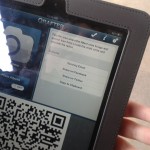PANNING
A shovelful of sand, gravel and clay from the creek bed was placed in a pan. The prospector then PUDDLED the mixture. This means he placed the pan in flowing water, broke up the clay with his hands and mixed it with the water so that the water washed the clay away. Any large stones would then be removed. Shaking the pan well to cause gold particles to sink to the bottom of the pan, the prospector would tilt it, and with a circular backward and forward motion, swirl the water in the pan, allowing a little gravel to be washed over the lip of the pan into the creek. When the last of the sand had been gently washed off, any gold in the washdirt was left in the pan. The prospector would then sharply swirl the remaining water to spread out any specks of gold over the bottom of the pan.
CRADLING
Panning was slow, back-breaking work, so the next development was the cradle. The cradle consisted of a box, fitted on rockers, so that the operator rocked it to and fro. Inside the cradle was two sloping shelves with thin strips of wood fastened across them. These were called RIFFLES. On the top of the box part of the cradle was a sieve made of metal plate with holes punched in it. Often, two men worked the cradle, one shovelling the washdirt onto the sieve and the other working the cradle with one hand and using a DIPPER with the other to take water from the creek and pour it over the washdirt as the cradle was rocked. The sieve prevented any large pieces of stone going into the box. These pieces were checked at intervals to be sure none were nuggets and the sieve was emptied. The gold-bearing gravel passing through the sieve was washed down through the shelves and any gold present was caught in the riffles, while the gravel was carried through a chute back into the creek. Often blanket, felt or corduroy was fitted to the floor of the chute to catch any fine gold dust missed by the riffles.
PUDDLING MACHINE – Used for deeper mines
This was used by wealthier miners as a horse was needed and they were very expensive to buy and feed. As the miners dug, every bucketful of dirt removed would have to be washed and checked for gold. The stiff, yellow clay was very difficult to break up, so a PUDDLING MACHINE was often used to break up the washdirt and allow the gold to sink. Water and washdirt were added to a circular trough and the mixture stirred by a horse pulling a rake. The water became a soupy sludge, which allowed the heavy gold particles to sink to the bottom. The water was then drained off, and the layer of stones and gold left in the bottom of the trough was then panned, cradled or sluiced to recover the gold. Usually, one man on a goldfield would own and operate the puddling machine and miners would bring their dirt to the machine and pay the owner to put it through the puddling machine. All information and images sourced from Sovereign Hill Education
The Eureka Centre: Excellent resource for everything you need to know about the Eureka Rebellion
I will make an information page later today with instructions on how to link your objects and create a information note cards for your virtual projects 🙂
Mrs Booth










